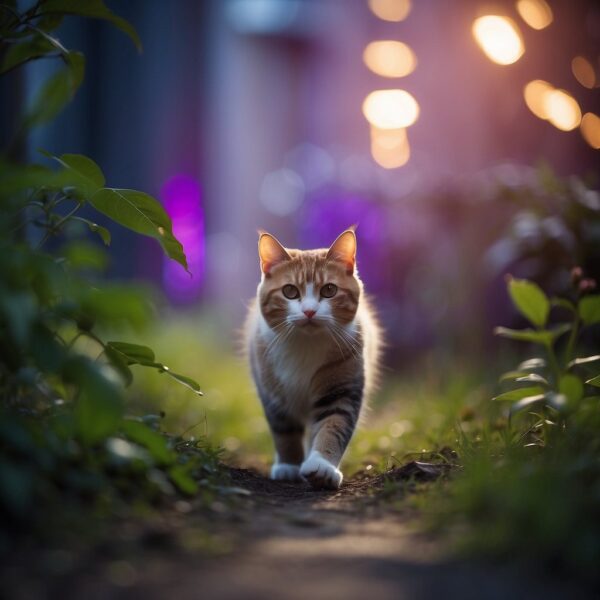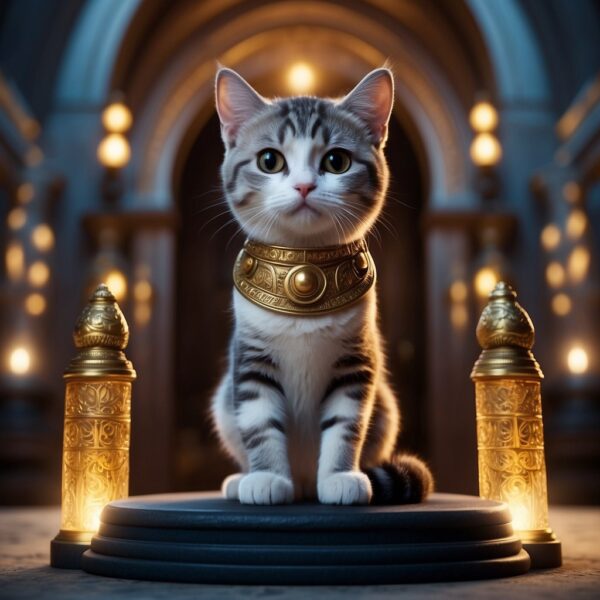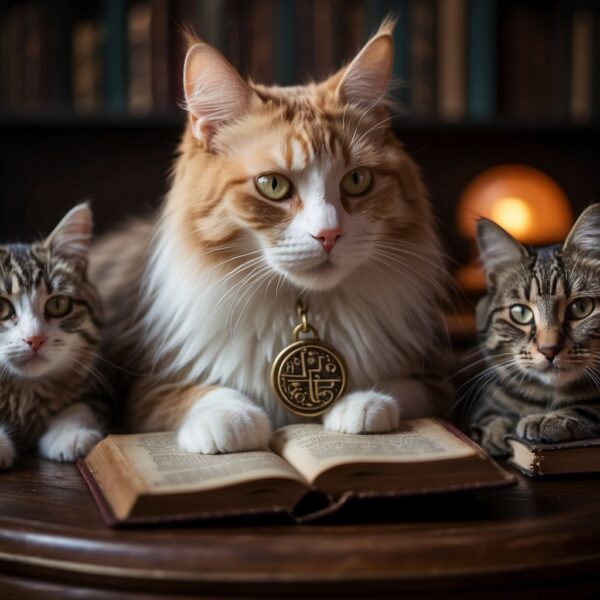
Cats Have Nine Lives Myth Origin and History
The saying “Cats have nine lives” is an enduring proverb that captures the essence of feline mystique and resilience. Over the centuries, this concept has weaved its way through various cultures and folklore, becoming a common colloquial expression representing the cat’s uncanny knack for survival. Rooted in historical beliefs and ancient mythologies, the proverb implies that cats possess the ability to escape from numerous life-threatening situations, essentially giving them multiple lives.
The myth’s popularity is often linked to the remarkable agility and survival instincts of cats, coupled with their importance in various mythologies and religions. Ancient Egypt is frequently cited as a key influencer of the myth, where cats were revered and sometimes deified. In Europe, during the Middle Ages, cats were associated with witchcraft and the supernatural, with their alleged nine lives partly stemming from their mysterious nature and the superstitious times. Today, while the myth persists in popular culture, scientific inquiry provides a more grounded understanding of the remarkable abilities of cats, debunking the literal interpretation of the phrase.
Key Takeaways
- The “nine lives” myth reflects the longstanding admiration for the cat’s survival instincts.
- Cultural beliefs and mythological associations contribute to the persistence of the phrase.
- Modern science offers explanations for cats’ agility and resilience, debunking literal interpretations.

Cats Have 9 Lives Historical Beliefs and Origins
The notion that cats possess multiple lives emerges from a tapestry of historical beliefs, where their seemingly mystical resilience to harm is echoed across cultures.
Ancient Egypt and Goddess Bastet
In Ancient Egypt, cats were revered, often linked to divinity and worship. Bastet, the goddess with the head of a lioness or a domestic cat, was at the center of this adoration. She embodied protection, fertility, and motherhood and was one of the prominent deities associated with cats and their venerated status. The creatures were so highly esteemed that harming a cat was considered a serious offense, indicative of their sacred standing within the society.
- Ancient Egyptian Beliefs:
- Cats held a protective role, safeguarded homes, and ensured the family’s well-being.
- Atum-Ra, believed to have transformed into a cat to slay the serpent Apep, further accentuated the cat’s revered role.
Mythology Across Cultures
The myth of cats having nine lives extends beyond Egypt, with traces found in European folklore as well. Cats were often subjects of superstition and associated with witchcraft and the supernatural. Their ability to survive in high-risk situations possibly gave rise to the legend which varies in number across different cultures. For example, in some Spanish-speaking regions, it is said that cats have seven lives.
- Greek and Roman Mythology:
- Cats were linked with deities such as Artemis and Diana, reflecting their divine and mystical attributes.
- Cultural perception of cats’ agility and survival instincts likely contributed to the myth’s foundation.

Cats in Myth and Religion
Cats have been revered and mystified throughout history, playing significant roles in various myths and religions. These creatures often carry a breadth of symbolic meaning, from divine representation to symbolizing spirits and deities.
Symbolism in Ancient Civilizations
In ancient civilizations, cats were more than just pets or hunters of vermin; they held profound symbolism. For instance, Ancient Egypt revered cats as sacred creatures. The goddess Bastet, depicted with a lioness or a domestic cat head, was worshipped as a protector of the home and bringer of good fortune. Cats were so revered that harming one was considered a heinous crime.
Hinduism also acknowledges the significance of cats. The goddess Shashthi is often portrayed as riding a cat, symbolizing fertility and childbirth protection. Cats are associated with mystery and magic, believed to possess an understanding of the divine unknown to humans.
Sacred Animals and Divine Associations
In the realm of the divine, cats frequently served as symbols or manifestations of gods and spirits. In Norse mythology, the fertility goddess Freyja rode a chariot pulled by cats, which were thought to bring good fortune and were a symbol of her sensual nature.
Other civilizations noted for their divine association with cats include many European cultures during the Middle Ages. Despite the dark period of association with witchcraft, cats were often seen as having supernatural powers and protective qualities.
Table: Feline Divinity across Cultures
| Civilization | Deity/Symbol | Associated Quality |
|---|---|---|
| Egyptian | Bastet | Protection, Fortune |
| Hindu | Shashthi | Fertility, Childbirth Protection |
| Norse | Freyja | Fertility, Fortune |
Through these examples, it is evident that cats have long held an esteemed place in myth and religion, symbolizing a wide range of divine attributes and revered as spirits with deep connections to the mystical world.
The Myth of cats have 9 Lives
The belief that cats possess multiple lives—specifically nine—stretches back centuries and permeates various cultures. This notion is often tied to a cat’s ability to escape from high-risk situations unscathed, rendering them somewhat mystical in the eyes of humans.
cats have 9 Lives Myth in Literature
The association of cats with having nine lives has been explored in prose and poetry alike, with European folklore frequently touching upon this motif. The number nine itself is often regarded as a magical number, signifying luck and enchantment across different traditions and stories. Literature has preserved the myth, allowing it to endure as a common metaphor for resilience and fortitude.
Shakespeare’s Reference
The myth gains a memorable nod in English literature through the works of Shakespeare. In “Romeo and Juliet,” one of Shakespeare’s most famous tragedies, the character Mercutio jests with Tybalt, referencing a cat’s nine lives. This allusion by Shakespeare indicates that the idea of cats having nine lives was already well-established in Old English Proverb and popular discourse by the late 16th century.
Cultural Representations and Associations
The idea that cats have nine lives spans numerous cultures and has been represented in various forms of media, from folk tales to modern entertainment. This expression reflects the cat’s agility and resilience, and has been particularly influential in depictions of witchcraft, as well as in the portrayal of cats in contemporary pop culture.
Witchcraft and the Middle Ages
Throughout the Middle Ages, black cats became symbolically intertwined with witchcraft and dark omens. Black Cats were thought to be witches’ companions, due to their nocturnal nature and mysterious demeanor, often considered a bad omen and were associated with Bad Luck. Relations between cats and alleged witches led to the animals being included in witch trials and folklore as familiars—supernatural entities believed to assist witches. In some tales, these cats were said to possess multiple lives, making them a significant figure in tales of magic.
Pop Culture References
Cats and their mystical lives have made many appearances in Films and TV Shows, serving as compelling elements for plot development and character arcs.
- Films: Felines are often portrayed as possessing supernatural wisdom or abilities, with their purported nine lives adding intrigue.
- For example, the cat in the film “Coraline” acts as a guide, doling out cryptic advice and displaying a seemingly mystical ability to traverse different worlds.
- TV Shows: They often feature cats in roles that capitalize on their reputed nine lives to craft engaging, sometimes humorous storylines.
- An instance can be seen in the animated series “Sabrina the Teenage Witch,” where the cat Salem is a central character, blending the themes of witchcraft with the urban legend of the cat’s multiple lives.
In the realm of music, Artists have occasionally drawn on the theme of cats and their multiple lives as metaphors in lyrics, playing on the imagery of survival and reinvention.
Scientific Perspectives
In evaluating the origins of the myth that cats have nine lives, scientific inquiry focuses on the physical attributes and behaviors that contribute to a cat’s reputation for survivability.
Feline Agility and Reflexes
Cats are known for their extraordinary agility and reflexes. These attributes are the result of a highly refined musculoskeletal system and an acute sense of balance. Specifically, they are endowed with a righting reflex, which typically allows them to land on their feet when they fall. This reflex begins to appear at 3 weeks of age and is perfected by 7 weeks. This ability to escape injury when falling from heights plays a substantial role in the perception of their survival skills.
Survival and Resilience
Cats often survive accidents and illnesses that can seriously endanger or even end the lives of other creatures, lending credence to their survival prowess. This resilience can be attributed to their instinctual behaviors, such as their tendency to hide when sick or injured, which can protect them from predators. Their genetic makeup and adaptability also contribute to their ability to survive in various environments. This resilience, coupled with their impressive reflexes and agility, helps to explain the myth’s endurance through history.
The Reality Behind the Myth cats have 9 lives
Exploring the myth of cats having nine lives reveals a blend of mystical beliefs and scientific explanations. This section will dissect common misconceptions and provide scientific insight into the physical abilities of cats.
Common Misconceptions
Firstly, it’s important to note magic or magical powers attributed to cats are rooted in myth and folklore, not reality. The mystical association of cats with multiple lives likely originated from their seemingly miraculous escapes from perilous situations. In ancient cultures, especially Egyptian, cats were often associated with the divine, enhancing their mystical aura.
Scientific Explanations
From a scientific standpoint, cats do not possess magical abilities but are indeed remarkable creatures with impressive survival instincts. For example:
- Cats Always Land on Their Feet: A cat’s righting reflex allows it to twist its body in mid-air if it falls, increasing the chances of landing on its feet. This ability is not magic but a combination of flexible spine and no functional clavicle.
Scientific observations confirm cats’ agility and reflexes contribute to their reputation for surviving various situations which, to the casual observer, might appear as if they cheated death multiple times.

Frequently Asked Questions
This section addresses common inquires about the origins, cultural significance, and interpretations of the myth that cats have nine lives.
What is the origin of the myth that cats have 9 lives?
The myth’s origin is likely rooted in folklore, with indications that it was known in Europe, particularly during the Middle Ages. Cats’ agility and ability to survive in various situations may have contributed to the belief in their multiple lives.
How did the saying ‘a cat has nine lives’ come to be?
The saying grew from observations of cats’ physical abilities, especially their knack for escaping death. Over time, this evolved into the saying as it was passed through generations and across cultures.
What cultural or historical significance does the ‘nine lives’ belief hold for cats?
Historically, cats were often associated with mysticism and the supernatural. The ‘nine lives’ belief reflects the fascination and reverence towards cats’ resilience and nine associated with eternity or completeness in various mythologies.
Is there a difference in the number of lives attributed to cats in various cultures?
Yes, some cultures attribute different numbers of lives to cats. For instance, some Spanish-speaking regions believe cats have seven lives, while Turkish and Arabic legends claim that cats have six lives.
What is the explanation behind the proverb ‘a cat has 9 lives’?
The explanation behind the proverb is grounded in the observation of cats’ natural survival instincts, such as landing on their feet from falls, helping the notion that they can survive scenarios that might be fatal to other animals.
In what ways has the ‘nine lives’ tale been interpreted or used in literature and folklore?
In literature and folklore, the ‘nine lives’ tale often symbolizes luck or resilience. It is used to illustrate characters that escape danger narrowly or survive against the odds, reflecting the enduring human admiration for the mysterious and elusive nature of cats.